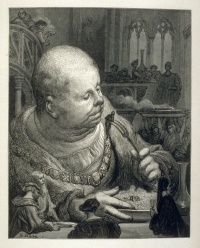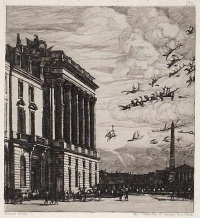Engraving
From The Art and Popular Culture Encyclopedia

|
"During the Middle Ages engraving and etching were added to the woodcut; at the beginning of the nineteenth century lithography made its appearance." --"The Work of Art in the Age of Mechanical Reproduction" (1935) by Walter Benjamin "The world—and even the world of artists—is full of people who can go to the Louvre, walk rapidly, without so much as a glance, past rows of very interesting, though secondary, pictures, to come to a rapturous halt in front of a Titian or Raphael—one of those that would have been most popularized by the engraver’s art; then they will go home happy, not a few saying to themselves, 'I know my Museum.'" --The Painter of Modern Life (1863) by Charles Baudelaire, tr. Mayne |

|
Related e |
|
Featured: |
Engraving is the practice of incising a design on to a hard, usually flat surface, by cutting grooves into it. The result may be a decorated object in itself, as when silver, gold, steel, or glass are engraved, or may provide an intaglio printing plate, of copper or another metal, for printing images on paper as prints or illustrations; these images are also called engravings.
Engraving was a historically important method of producing images on paper, both in artistic printmaking, and also for commercial reproductions and illustrations for books and magazines. It has long been replaced by photography in its commercial applications and, partly because of the difficulty of learning the technique, is much less common in printmaking, where it has been largely replaced by etching and other techniques.
Traditional engraving, by burin or with the use of machines, continues to be practiced by goldsmiths, glass engravers, gunsmiths and others, while modern industrial techniques such as photoengraving and laser engraving have many important applications. Engraved gems were an important art in the ancient world, revived at the Renaissance, although the term traditionally covers relief as well as intaglio carvings, and is essentially a branch of sculpture rather than engraving, as drills were the usual tools.
Contents |
History
For the printing process, see intaglio (printmaking). For the Western art history of engraved prints, see old master print and line engraving
The first evidence for humans engraving patterns are hatched banding upon ostrich eggshells used as water containers found in South Africa in the Diepkloof Rock Shelter and dated to the Middle Stone Age around 60,000 BP. Engraving on bone and ivory is an important technique for the Art of the Upper Paleolithic, and larger engraved petroglyphs on rocks are found from many prehistoric periods and cultures around the world.
In antiquity, the only engraving on metal that could be carried out is the shallow grooves found in some jewellery after the beginning of the 1st Millennium B.C. The majority of so-called engraved designs on ancient gold rings or other items were produced by chasing or sometimes a combination of lost-wax casting and chasing. Engraved gem is a term for any carved or engraved semi-precious stone; this was an important small-scale art form in the ancient world, and remained popular until the 19th century.
However the use of glass engraving, usually using a wheel, to cut decorative scenes or figures into glass vessels, in imitation of hardstone carvings, appears as early as the first century AD, continuing into the fourth century CE at urban centers such as Cologne and Rome, and appears to have ceased sometime in the fifth century. Decoration was first based on Greek mythology, before hunting and circus scenes became popular, as well as imagery drawn from the Old and New Testament. It appears to have been used to mimic the appearance of precious metal wares during the same period, including the application of gold leaf, and could be cut free-hand or with lathes. As many as twenty separate stylistic workshops have been identified, and it seems likely that the engraver and vessel producer were separate craftsmen.
In the European Middle Ages goldsmiths used engraving to decorate and inscribe metalwork. It is thought that they began to print impressions of their designs to record them. From this grew the engraving of copper printing plates to produce artistic images on paper, known as old master prints in Germany in the 1430s. Italy soon followed. Many early engravers came from a goldsmithing background. The first and greatest period of the engraving was from about 1470 to 1530, with such masters as Martin Schongauer, Albrecht Dürer, and Lucas van Leiden.
Thereafter engraving tended to lose ground to etching, which was a much easier technique for the artist to learn. But many prints combined the two techniques: although Rembrandt's prints are generally all called etchings for convenience, many of them have some burin or drypoint work, and some have nothing else. By the nineteenth century, most engraving was for commercial illustration.
Before the advent of photography, engraving was used to reproduce other forms of art, for example paintings. Engravings continued to be common in newspapers and many books into the early 20th century, as they were cheaper to use in printing than photographic images. Engraving has also always been used as a method of original artistic expression.
Many classic postage stamps were engraved, although the practice is now mostly confined to particular countries, or used when a more "elegant" design is desired and a limited color range is acceptable.
A renaissance in hand-engraving
During the mid-1900s, a renaissance in hand-engraving began to take place. With the inventions of pneumatic hand-engraving systems that aided hand-engravers, the art and techniques of hand-engraving became more accessible. In the years past, hand-engraving was an extremely secretive art where masters would carefully and rarely choose apprentices to pass on the trade. Even into the 1970s, many engravers were reluctant to share trade secrets and kept methods closely guarded.
Noted engravers
Prints (see also List of Printmakers):
- Jacopo de' Barbari (active 1500-1515)
- Theodore de Bry (1528-1598)
- William Blake (1757-1827)
- Giulio Campagnola (active c.1505-1515)
- Gustave Doré (1832–1883)
- Albrecht Dürer (1471–1528)
- Master ES (active c.1450-1470)
- Maso Finiguerra (1426-1464)
- Hendrick Goltzius (c.1558-1617)
- Francisco de Goya (1746-1828)
- Stanley William Hayter (1901-1988)
- William Hogarth (1697–1764)
- Helen Hyde (1868-1919)
- Lucas van Leyden (1494-1533)
- Andrea Mantegna (c.1431-1506)
- Claude Mellan (1598-1688)
- Israhel van Meckenem (c.1445-1501)
- Matthäus Merian (1593-1650)
- José Guadalupe Posada (1852-1913)
- Jan Saenredam (1565-1607)
- Martin Schöngauer (c.1450-1491)
- John Sturt (1658-1730)
- Maerten de Vos (1532-1603)
- Anthonie Wierix (1552-1624)
- Hieronymus Wierix (1553-1619)
Of gems:
- Theodorus of Samos,Polycrates' gem-engraver
- Pyrgoteles, Alexander's gem-engraver
Of guns:
- A. B. Bradshaw (Firearm Engraver)
- Thierry Duguet
- Geoffroy Gournet
- Ken Hunt (engraver)
- Harry Kell
- Harry Morris (sometimes Henry Morris)
- Jack Sumner
- Sam Alfano
Of coins:
Of postage stamps:
See also

